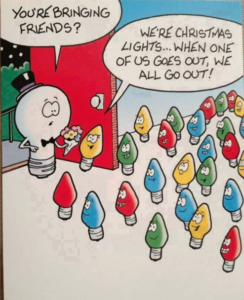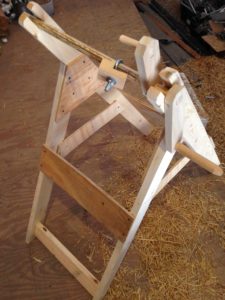Christmas lights make this time of year festive and bright… but oh so frustrating! Here at the Arboretum we put up thousands of lights every year in preparation for our annual Luminary Walk. We put them on the buildings, string them in the grass and hang them in trees. We know a thing or two about the misery those little twinkle lights can bring. Impossible to fix and eternally tangled, and how do you store them for next year so they don’t drive you crazy all over again?

Cartoon by Mark Parisi – more Christmas funnies at https://www.offthemark.com/
Fear not, Christmas merrymakers! Here are a few tips to keep you from turning into a Christmas light scrooge.
Invest in the Right Tools
When light strands go on the fritz, there is no sense in wiggling every single bulb to see which is the troublemaker. That is the way of the past! If you, like me, have A LOT of lights to fiddle with, the best way to handle it is with a LightKeeper tool. This is what we use here to diagnose our strands of lights. It has a fuse/bulb/socket tester and current detector. Usually sold for about $20, it can save you a lot of time and trouble, preventing you from throwing lights in the garbage out of exasperation. This is most useful for incandescent types and only ‘kinda-sorta’ works on LEDs.
Note: In general LED lights seem to have less problems than the older style incandescent and the bulbs break much less often because they are plastic instead of glass. If you buying new, buy LED – less fixing and less energy usage.
Step by step, this is how I doctor our mini-incandescent Christmas lights:
- First look for obvious broken bulbs somewhere within in the section that isn’t working. Broken bulbs can disrupt the current.
- Inspect for chewed/broken wires (see next paragraph regarding rodents)
- Use LightKeeper tool to detect where the current stops — locate the problem area and test a few of those bulbs and sockets to find which one is burnt out/stopping current.
Step 3 is where you will spend most of your time, but what a feeling when it all finally lights up – you become Master of the Lights!

Me and my LightKeeper tool. If you want to be this happy, find a light fixing tool that works for you! Perhaps they will hire me for an infomercial….
Never Underestimate Your Resident Rodents
If you store your Christmas lights in an attic, garage, or shed, you may have rodent problems. These green and white wires are irresistible to little nibbling creatures – mice, rats, squirrels and bunnies. Even after you put them outside on your roof and shrubs you are still vulnerable to those maniacal munchers. You can change every bulb in that strand of lights but if a mouse or rabbit has chewed through one of the wires, no go! Before giving up on a particularly stubborn set of lights, run the entire length of it through your hands (unplugged) and check for any exposed wires that might be causing the issue. It can be easily fixed by stripping the plastic off the wire and twisting them back together with a wire nut from the local hardware store.
Take a Break and Dry Out
If your lights quit working in the wet weather, don’t force it. Many of our older sets of lights act up in sleet and slush, probably due to loose bulbs allowing minuscule amounts of moisture into the connections. It can also be caused by a weak spot in the extension cords exposed to wet conditions and tripping your safety functions at the outlet. The best option here is to let the lights and cords dry out and get back to fixing them when you actually have a chance!
Smart Storage
All the work you did this year will be for not if you don’t store your lights properly! Organization is the name of the game. Broken bulbs will result from over stacking or crunching. Tangles will re-form if you just throw them in boxes or roll them up without securing the loop. We have created a stand and roller system for neatly and carefully rolling up the our strings of lights.
For fewer lights you may consider wrapping them around a piece of cardboard/wood or around cylinders (coffee cans? giant spools?) for storage. We keep all our lights coiled and shelved for the off season, many sets labeled for their specific area so there is no guessing about what fits where next year.

One of our volunteers constructed a standing crank for us to spool the Christmas lights onto. Very handy and easy on my back!
I hope you all spend less time fixing your decorations and more time enjoying them. Merry Christmas friends, may it be bright!

